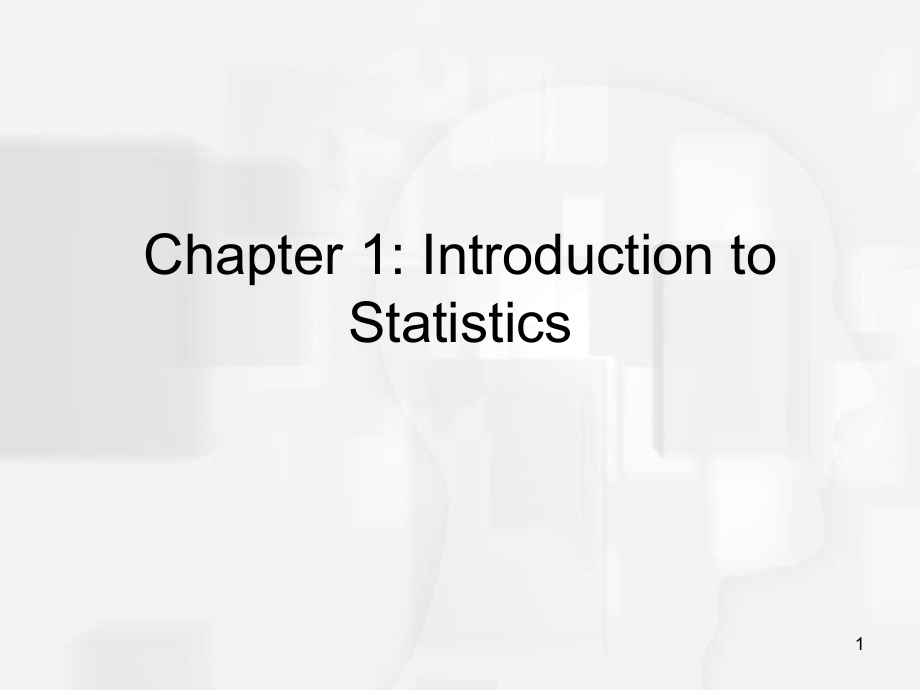 心理统计学英文课件:L1 Introduction to Statistics
心理统计学英文课件:L1 Introduction to Statistics



《心理统计学英文课件:L1 Introduction to Statistics》由会员分享,可在线阅读,更多相关《心理统计学英文课件:L1 Introduction to Statistics(25页珍藏版)》请在装配图网上搜索。
1、1Chapter 1:Introduction to Statistics2Variables A variable is a characteristic or condition that can change or take on different values.Most research begins with a general question about the relationship between two variables for a specific group of individuals.3Population The entire group of indivi
2、duals is called the population.For example,a researcher may be interested in the relation between class size(variable 1)and academic performance(variable 2)for the population of third-grade children.4Sample Usually populations are so large that a researcher cannot examine the entire group.Therefore,
3、a sample is selected to represent the population in a research study.The goal is to use the results obtained from the sample to help answer questions about the population.6Types of Variables Variables can be classified as discrete or continuous.Discrete variables(such as class size)consist of indivi
4、sible categories,and continuous variables(such as time or weight)are infinitely divisible into whatever units a researcher may choose.For example,time can be measured to the nearest minute,second,half-second,etc.7Real Limits To define the units for a continuous variable,a researcher must use real li
5、mits which are boundaries located exactly half-way between adjacent categories.8Measuring Variables To establish relationships between variables,researchers must observe the variables and record their observations.This requires that the variables be measured.The process of measuring a variable requi
6、res a set of categories called a scale of measurement and a process that classifies each individual into one category.94 Types of Measurement Scales1.A nominal scale is an unordered set of categories identified only by name.Nominal measurements only permit you to determine whether two individuals ar
7、e the same or different.2.An ordinal scale is an ordered set of categories.Ordinal measurements tell you the direction of difference between two individuals.104 Types of Measurement Scales3.An interval scale is an ordered series of equal-sized categories.Interval measurements identify the direction
8、and magnitude of a difference.The zero point is located arbitrarily on an interval scale.4.A ratio scale is an interval scale where a value of zero indicates none of the variable.Ratio measurements identify the direction and magnitude of differences and allow ratio comparisons of measurements.11Corr
9、elational Studies The goal of a correlational study is to determine whether there is a relationship between two variables and to describe the relationship.A correlational study simply observes the two variables as they exist naturally.13Experiments The goal of an experiment is to demonstrate a cause
10、-and-effect relationship between two variables;that is,to show that changing the value of one variable causes changes to occur in a second variable.14Experiments(cont.)In an experiment,one variable is manipulated to create treatment conditions.A second variable is observed and measured to obtain sco
11、res for a group of individuals in each of the treatment conditions.The measurements are then compared to see if there are differences between treatment conditions.All other variables are controlled to prevent them from influencing the results.In an experiment,the manipulated variable is called the i
12、ndependent variable and the observed variable is the dependent variable.16Other Types of Studies Other types of research studies,know as non-experimental or quasi-experimental,are similar to experiments because they also compare groups of scores.These studies do not use a manipulated variable to dif
13、ferentiate the groups.Instead,the variable that differentiates the groups is usually a pre-existing participant variable(such as male/female)or a time variable(such as before/after).17Other Types of Studies(cont.)Because these studies do not use the manipulation and control of true experiments,they
14、cannot demonstrate cause and effect relationships.As a result,they are similar to correlational research because they simply demonstrate and describe relationships.19Data The measurements obtained in a research study are called the data.The goal of statistics is to help researchers organize and inte
15、rpret the data.20Descriptive Statistics Descriptive statistics are methods for organizing and summarizing data.For example,tables or graphs are used to organize data,and descriptive values such as the average score are used to summarize data.A descriptive value for a population is called a parameter
16、 and a descriptive value for a sample is called a statistic.21Inferential Statistics Inferential statistics are methods for using sample data to make general conclusions(inferences)about populations.Because a sample is typically only a part of the whole population,sample data provide only limited in
17、formation about the population.As a result,sample statistics are generally imperfect representatives of the corresponding population parameters.22Sampling Error The discrepancy between a sample statistic and its population parameter is called sampling error.Defining and measuring sampling error is a
18、 large part of inferential statistics.24Notation The individual measurements or scores obtained for a research participant will be identified by the letter X(or X and Y if there are multiple scores for each individual).The number of scores in a data set will be identified by N for a population or n
19、for a sample.Summing a set of values is a common operation in statistics and has its own notation.The Greek letter sigma,will be used to stand for the sum of.For example,X identifies the sum of the scores.25Order of Operations1.All calculations within parentheses are done first.2.Squaring or raising to other exponents is done second.3.Multiplying,and dividing are done third,and should be completed in order from left to right.4.Summation with the notation is done next.5.Any additional adding and subtracting is done last and should be completed in order from left to right.
- 温馨提示:
1: 本站所有资源如无特殊说明,都需要本地电脑安装OFFICE2007和PDF阅读器。图纸软件为CAD,CAXA,PROE,UG,SolidWorks等.压缩文件请下载最新的WinRAR软件解压。
2: 本站的文档不包含任何第三方提供的附件图纸等,如果需要附件,请联系上传者。文件的所有权益归上传用户所有。
3.本站RAR压缩包中若带图纸,网页内容里面会有图纸预览,若没有图纸预览就没有图纸。
4. 未经权益所有人同意不得将文件中的内容挪作商业或盈利用途。
5. 装配图网仅提供信息存储空间,仅对用户上传内容的表现方式做保护处理,对用户上传分享的文档内容本身不做任何修改或编辑,并不能对任何下载内容负责。
6. 下载文件中如有侵权或不适当内容,请与我们联系,我们立即纠正。
7. 本站不保证下载资源的准确性、安全性和完整性, 同时也不承担用户因使用这些下载资源对自己和他人造成任何形式的伤害或损失。
